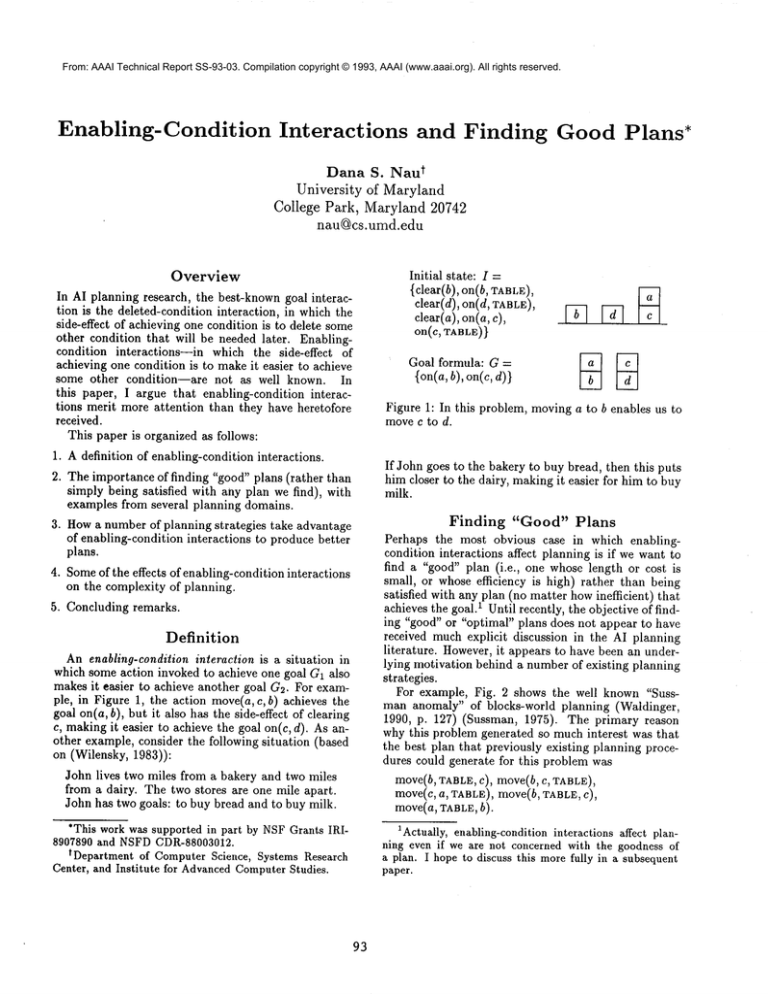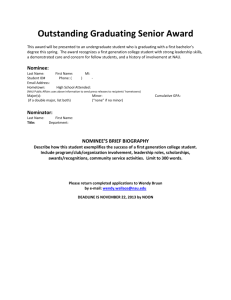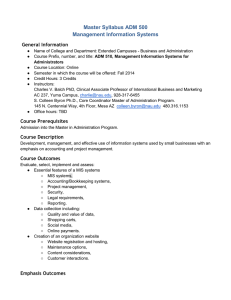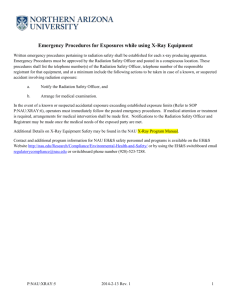
From: AAAI Technical Report SS-93-03. Compilation copyright © 1993, AAAI (www.aaai.org). All rights reserved.
Enabling-Condition
Interactions
and Finding
Good Plans*
Dana S. tNau
University
of Maryland
College Park, Maryland 20742
nau~cs.umd.edu
Overview
Initial state: I =
In AI planning research, the best-known goal interaction is the deleted-condition interaction, in which the
side-effect of achieving one condition is to delete some
other condition that will be needed later. Enablingcondition interactions--in
which the side-effect of
achieving one condition is to make it easier to achieve
some other condition--are
not as well known. In
this paper, I argue that enabling-condition interactions merit more attention than they have heretofore
received.
This paper is organized as follows:
1. A definition of enabling-condition interactions.
2. The importance of finding "good" plans (rather than
simply being satisfied with any plan we find), with
examples from several planning domains.
3. Howa number of planning strategies take advantage
of enabling-condition interactions to produce better
plans.
4. Someof the effects of enabling-condition interactions
on the complexity of planning.
5. Concluding remarks.
Definition
An enabling-condition interaction is a situation in
which some action invoked to achieve one goal G1 also
makes it easier to achieve another goal G2. For example, in Figure 1, the action move(a, c,b) achieves the
goal on(a, b), hut it also has the side-effect of clearing
c, makingit easier to achieve the goal on(c, d). As another example, consider the following situation (based
on (Wilensky, 1983)):
John lives two miles from a bakery and two miles
from a dairy. The two stores are one mile apart.
John has two goals: to buy bread and to buy milk.
{clear(b),
on(b,
TABLE),
clear(d), on(d, TABLE),
clear(a),on(a,c),
on(c, TABLE)
Goal formula:
{on(a, b), on(c,
a =
[-~
~-~
~
Figure 1: In this problem, movinga to b enables us to
movec to d.
If John goes to the bakery to buy bread, then this puts
him closer to the dairy, makingit easier for him to buy
milk.
Finding
"Good" Plans
Perhaps the most obvious case in which enablingcondition interactions affect planning is if we want to
find a "good" plan (i.e., one whose length or cost is
small, or whose efficiency is high) rather than being
satisfied with any plan (no matter howinefficient) that
achieves the goal.1 Until recently, the objective of finding "good" or "optimal" plans does not appear to have
received muchexplicit discussion in the AI planning
literature. However,it appears to have been an underlying motivation behind a number of existing planning
strategies.
For example, Fig. 2 shows the well known "Sussman anomaly" of blocks-world planning (Waldinger,
1990, p. 127) (Sussman, 1975). The primary reason
why this problem generated so much interest was that
the best plan that previously existing planning procedures could generate for this problem was
move(b, TABLE, C), move(b, c, TABLE),
move(c, a, TABLE),move(b, TABLE, C),
move(a, TABLE,b).
*This work was supported in part by NSFGrants IRI8907890 and NSFDCDR-88003012.
tDepartment of Computer Science, Systems Research
Center, and Institute for AdvancedComputerStudies.
1Actually, enabling-condition interactions affect planning even if we are not concerned with the goodness of
a plan. I hope to discuss this more fully in a subsequent
paper.
93
be a set of alternative schedules for producing it, and
each such schedule consists of a set of operations to
be performed on various machines. An operation in a
schedule is usually associated with a machinefor carrying it out. If two or more operations require the same
type of set-up, then doing them on the same machine
may reduce the total time required--and thus reduce
the total time required to complete all the schedules.
Initial state: I -{clear(e), clear(b),
on(a, TABLE),on(c,
on(b, TABLE)}
Goal formula: G =
{on(a, b), on(b,
Multiple
Database-Query
Optimization
Let Q = {Q1, Q2,..., Qn} be a set of database queries.
Associated with each query Qi is a set of alternate
access plans {Pil, Pi2,..., Pike}. Each plan is a set of
partially ordered tasks that produces the answer to Q.
For example, one task might be to find all employees
in some department whose ages are less than 30, and
whose salaries are over $50,000. Each task has a cost,
and the cost of a plan is the sumof the costs of its tasks.
Enabling-condition interactions occur if plans for two
different tasks contain the samequery, or if the result of
evaluating one task reduces the cost of evaluating the
other. A better overall plan can be produced by taking
advantage of these interactions, and several research
papers have been written on this topic (Sellis, 1988;
Shimel al., 1991).
Figure 2: The Sussman anomaly.
This plan does achieve the desired goal, but it does so
inefficiently. If we did not care about the goodness of
the plan, then the Sussman anomaly would be of no
concern.
In addition, there are a numberof practical planning
situations in which it is important to find good plans.
Below are several examples.
Machining-Operation
Sequencing
Consider the problem of using machining operations
to make holes in a metal block. Several different kinds
of hole-creation operations are available (twist-drilling,
spade-drilling, gun-drilling, etc.), as well as several different kinds of hole-improvement operations (reaming,
boring, grinding, etc.). Each time one switches to
different kind of operation or to a hole of a different
diameter, one must mount a different cutting tool on
the machine tool. If the same machining operation is
to be performed on two different holes of the same diameter, then these two operations can be merged by
omitting the task of changing the cutting tool. Thus,
by performing the two operations at the same time,
both are made easier. This and several other similar manufacturing problems are of practical significance (Chang and Wysk, 1985; Hayes, 1987; Nau, 1987;
Nauet al., 1988; Mantyla and Opas, 1988).
Planning
Strategies
A number of planning strategies have been formulated
to exploit enabling-condition interactions in order to
produce better plans. Below are two examples.
Studies of human planning behavior show that people look for enabling-condition interactions when they
are formulating plans, in order to make-the plans
more efficient. For example, consider the following excerpt from Hayes-Roth and Hayes-lZoth’s transcript of
someone "thinking aloud" while planning a hypothetical day’s errands (Hayes-Roth and Hayes-Roth, 1990,
p. 254):
In section 6, the subject asks, "What is going to
be the closest one?" This question indicates a
strategic decision to plan to perform the closest
errand next in the procedural sequence ...
Logistics
Planning
Different plans containing deliveries to the same place
maybe combinedinto a single trip, saving considerable
expense. In addition, an inexpensive delivery technique needed for one delivery can be subsumed by one
with a greater cost in a second plan, while still allowing for an overall savings. For example, if a cargo of
food could be delivered to a location via a parachute
drop, but some other piece of equipment going to the
same site requires a landing, then both items can be
delivered on the same plane (the one that lands) and
the extra steps required for the parachute drop can be
deleted.
This planning strategy is one that Pollack (Pollack,
1992) has referred to as overloading: if you notice that
an action you have selected in order to accomplish one
goal also makes it easier to accomplish another goal,
then use that action for both of these purposes.
The same basic idea has been incorporated into
nonlinear planning systems, where it is sometimes
called phanlomization: SIPE (Wilkins, 1988), Nonlin
(Tate, 1977), and Kambhampati’s plan reuse framework (Kambhampati, 1990) are capable of recognizing
an operator in the current plan satisfies another goal
in addition to the one it was originally intended to
achieve, and imposing constraints on the plan so that
this operator will be used to achieve both goals.
Scheduling
Consider the problem of finding a schedule for satisfying some set of orders for products that can be produced in a machine shop. For each order, there may
94
ad
b
d
e
e
da
"
¢
e
~
a is in d’s way and d is in a’s way, so {a, d} is deadlocked.
b
d
C
e
C
e
a
a
b
b
a is in its ownway, so Ca} is deadlocked.
Initial state: I = Cclear(a), on(a, b), on(b, c),
on(c, TABLE),clear(d), on(d, e), TABLE)
Goal formula: G =
Con(a,e), on(e, b), on(d,
Figure 3: A problem in which two sets of blocks are deadlocked: Ca, d} and {a}.
A different but related strategy is action merging
(Yang et al., 1990; Foulser et al., 1992; Yang el al.,
1993). In this case, rather than simply recognizing that
an existing action accomplishes an additional goal, the
planner replaces an action that doesn’t accomplish an
additional goal with one that does (provided that this
produces a lower total cost than would be incurred
by using a separate action to achieve the additional
goal). NOAH’s"eliminate redundant precondition"
critic (Sacerdoti, 1977) is a special case of this strategy.
Effects
can easily find an optimal plan, regardless of whether
or not the problem contains any deleted-condition interactions.
To see that deadlocks are a special case of enabling:
condition interactions, consider the definition of a
deadlock given in (Gupta and Nau, 1992). The set
of blocks {bl, b2,..., by} is deadlockedin the state S if
there is a set of blocks Cdl, d2,..., dr} such that the
following three conditions hold:
1. In S, bi is above di for i = 1,2,...,p.
2. In G, bi is
1, and b
v above di+l for i = 1,2,...,pis abovedl.
3. In S, none of bl, b2,..., bp are in their final positions
(if p > 1, then the other two conditions entail this
condition).
For example, in Figure 3, in the initial state I there
are two deadlocked sets of blocks:
1. In I, a is above c and d is above e. In G, a is above
e and d is above c. Thus {a, d} is deadlocked.
2. a is aboveb in both I and G, and a is not in its final
position in I. Thus {a} is deadlocked.
Suppose some set of blocks D1 = {a,b} is deadlocked. Then before we can movea and b to their final
positions, we must resolve the deadlock by moving either a or b out of the way. Now, suppose that a is
also in some other deadlocked set D2, and b is also
in some other deadlocked set D3. Then there are two
enabling-condition interactions: moving a out of the
way will also resolve the deadlock D2, and moving b
out of the way will also resolve deadlock /93. Since
these two possible moveswill have side-effects of making different sets of goals easier to achieve later on, it
is unclear which of of the two moveswe should prefer.
As shown in (Gupta and Nau, 1992), in the general
case of this problem it is NP-hard to find an optimal
plan.
on Complexity
If a problem contains more than one enabling-condition
interaction, then it can be difficult to determine which
set of actions will produce the best plan. For example, if actions A and B both achieve goal G1, and A
also aids in achieving goal G~, then we might prefer
action A to action B--but if B also aids in achieving goal G3, then it may no longer be clear which of
A and B we should prefer. The difficulty of resolving such tradeoffs is illustrated in someof the repeated
revisions that Hayes-Roth and Hayes-Roth’s subject
makes to his plan (Hayes-Roth and ttayes-Roth, 1990,
p. 246-247). Below, I discuss several other cases where
enabling-condition interactions increase the difficulty
of planning.
Blocks World (The Usual Formulation)
The effect of enabling-condition interactions on blocksworld planning was analyzed formally in (Gupta and
Nau, 1992). This paper showed that in the blocks
world, finding an optimal plan is NP-hard--and that
the NP-hardness is not due to deleted-condition interactions such as the Sussman anomaly, but instead due
to a particular kind of enabling-condition interaction
called a deadlock. For problems that do not contain
deadlocks, there is a simple hill-climbing strategy that
95
Table 1: Complexity of domain-independent planning. These results
of whether or not conditional operators are allowed.
Lang.
restrictions
no
How the
operators
are given
given
in the
input
Allow
delete
lists?
yes
Allow negated preconditions?
yes/no
are independent
Telling
whether a
plan exists
Telling whether
there is a plan
of length _< k
EXPSPACE-Comp.
NEXPTIME-comp.
function
yes
NEXPTIME-Comp.
NEXPTIME-comp.
symno
no
EXPTIME-comp.
NEXPTIME-Comp.
ano
PSPACE-complete PSPACE-COmp.
bols;
finitely
yes
yes/no
PSPACE 7
PSPACE "/
many
fixed in
yes
NP 7
NP 7
constant
advance
no
no
P
NP 7
a
no
symbols
NLOGSPACE
NP
~
given
all preyes
PSPACE-comp.
PSPACE-comp.
yes/no
~
dicates
in the
yes
NP-complete
NP-complete
p6
are 0-ary input
no
no
NP-complete
pno’~/no
(propo
NLOGSPACE-comp.
NP-complete
sitions)
fixed
yes/no yes/no
constant time
constant time
~No operator has more inn one precondition.
ZEvery operator with > 1 precondition is the composition of other operators.
"~With PSPACEor Nl’-completeness for some sets of operators.
~Results from (Bylander, 1991).
Blocks World (Another
Formulation)
(Chenoweth, 1991) describes a more complicated version of blocks world planning, in which more than
one block can have the same name. It is an open
question how difficult deleted-condition interactions
are in Chenoweth’s version of the blocks world--but
Chenoweth’s NP-hardness proof for his domain again
shows that enabling-condition interactions make the
problem NP-hard.
Chenoweth’s proof of NP-hardness is by reduction
from 3SAT. Given a 3SATproblem with m clauses and
n variables, he generates an MPBW
problem in which
L = 3n + 5m+ 1. For each i (i = 1,...,n),
there are
two blocks namedul, at the tops of two large stacks.
For each i, one of the two ui’s must be movedto the
top of a block namedvi, and the question is which ui to
move.If we movethe wrong one, then later in the plan,
we will have to move one or more blocks temporarily
to the table rather than moving them directly to their
final positions, whencethe resulting plan will be longer
than L.
The above problem is similar to the problem of resolving multiple deadlocks in the more usual formulation of the blocks world. In both problems, if we make
the wrong choice, then too many blocks must be moved
temporarily to the table rather than directly to their
final positions. However, the two problems are not
identical. If no two blocks have the same name, then
for a wrong choice to force us to moveextra blocks to
the table, we must have blocks which mutually block
each others’ progress--and this led to our definition of
deadlock. But if more than one block can have the
same name, then one can find other ways for a wrong
96
Line
number
(1)
(2)
(a)
(4)
(5)
(6)
(7)
(S)
(9)
(10)
(11)
(12)
(13)
choice to force us to moveextra blocks to the table-and that is what Chenoweth did.
Domain-Independent
Planning
Enabling-condition interactions are important not only
in the blocks world, but in domain-independent planning in general. As an example, consider Table 1,
which was taken from (Erol et al., 1991; Erol et al.,
1992). This table shows how the complexity of domainindependent planning with STRIPS-style operators depends on the nature of those operators.
In lines (11) and (12) of Table 1, plan existence
be determined in polynomial time, but the problem of
finding an optimal plan is NP-complete. The reason
for this is as follows. In these cases, if we are simply
interested in finding a plan but do not care how good
a plan it is, the restrictions allow us to plan for each
subgoal separately, using backwards chaining. But if
we are interested in a short plan (i.e., one of length _<
for some k) rather than just any plan, then we need
to pay attention to enabling-condition interactions, because they make it possible to produce a shorter plan.
It is not possible to detect and reason about these interactions if we plan for the subgoals independently; instead, we have to consider all possible operator choices
and orderings, makingit NP-hard to tell whether there
is a plan of length < k.
Note Mso that throughout Table 1, whether or not
negated preconditions are allowed does not affect the
complexity of telling whether there is a plan of length
< k. Again, what makes these particular
problems
~fficult is howto handle multiple enabling-condition
interactions--more specifically, how to choose opera-
tors that achieve several subgoals in order to minimize
the overall length of the plan. For these problems,
this task remains equally hard regardless of whether
negated preconditions are allowed.
Conclusion
In AI planning research, the best-known goal interaction is the deleted-condition interaction, in which the
side-effect of achieving one condition is to delete some
other condition that will be needed later. Enablingcondition interactions are not as well known. In this
paper, I .have argued that enabling-condition interactions merit more attention, for the following reasons:
The goal of finding good plans (rather than simply
being satisfied with any plan we find) is important
in many planning situations, and has been an implicit motivation behind several existing planning
strategies. But if we are interested in finding good
plans rather than poor plans, enabling-condition
interactions can dramatically increase the difficulty of planning.
In addition, preliminary results suggest that even if
we don’t care about the quality of the plan we find,
enabling-condition interactions can still dramatically
increase the difficulty of planning. If this result is
correct, then it suggests that enabling-condition interactions are just as important in planning as deletedcondition interactions. I hope to investigate this issue
more fully in the future.
References
Bylander, Tom1991. Complexity results for planning.
In IJCAI-91.
Chang, T.C. and Wysk, R. A. 1985. Integrating cad
and cam through automated process planning. International Journal of Production Research 22(5).
Chenoweth, Stephen V. 1991. On the NP-hardness
of blocks world. In AAAI-91: Proc. Ninth National
Conf. Artificial Intelligence. 623-628.
Erol, K.; Nau, D.; and Subrahmanian, V. S. 1991.
Complexity, decidability and undecidability results
for domain-independent planning. Submitted for publication.
Erol, K.; Nau, D.; and Subrahmanian, V. S. 1992. On
the complexity of domain-independent planning. In
Proc. AAAI-92. 381-386.
Foulser, David; Li, Ming; and Yang, Qiang 1992. Theory and algorithms for plan merging. Artificial Intelligence 57(2-3):143-182.
Gupta, Naresh and Nau, Dana S. 1992. On the complexity of blocks-world planning. Artificial Intelligence 56(2-3):223-254.
Hayes-Roth, B. and Hayes-Roth, F. 1990. A cognitive
method of planning. In Allen, James; Hendler, James;
and Tate, Austin, editors 1990, Readings in Planning.
97
Morgan Kaufman. 245-262. Originally appeared in
Cognitive Science 3(4), 1979.
Hayes, Caroline 1987. Planning in the machining
domain: Using goal interactions
to guide search.
Master’s thesis, Carnegie-Mellon University, The
Robotics Institute, Pittsburgh, PA.
Kambhampati, Subbarao 1990. A theory of plan modification. In AAAI-90.
Mantyla, Martti and Opas, Jussi 1988. Hutcapp--a
machining operations planner. In Proc. Second International Symposium on Robotics and Manufacturing
Systems.
Nau, D. S.; Karinthi, R.; Vanecek, G.; and Yang,
Q. 1988. Integrating AI and solid modeling for design
and process planning. In Second IFIP Working Group
5.2 Workshop on Intelligent
CAD, Cambridge, UK.
University of Cambridge.
Nau, D. S. 1987. Automated process planning using
hierarchical abstraction. TI Technical Journal 3946. Award winner, Texas Instruments 1987 Call for
Papers on AI for Industrial Automation.
Pollack, Martha 1992. The uses of plans. Artificial
Intelligence 57(1):43-68.
Sacerdoti, E. D. 1977. A Structure for Plans and
Behavior. American Elsevier Publishing Company.
Sellis, T. 1988. Multiple-query optimization. ACM
Transactions on Database Systems 13(1):23-52.
Shim, K.; Sellis, T.; and Nau, D. 1991. Improvements
on a heuristic algorithm for multiple-query optimization. Submitted for publication.
Sussman, G.J. 1975. A Computational Model of Skill
Acquisition. American Elsevier, NewYork.
Tate, Austin 1977. Generating project networks. In
Proc. 5th International Joint Conf. Artificial Intelligence.
Waldinger, R. 1990. Achieving several goals simultaneously. In Allen, James; Hendler, James; and Tate,
Austin, editors 1990, Readings in Planning. Morgan
Kaufman. 118-139. Originally appeared in Machine
Intelligence 8, 1977.
Wilensky, R. 1983. Planning and Understanding.
Addison-Wesley.
Wilkins, David E. 1988. Practical Planning: Extending the Classical AI Planning Paradigm. MorganKaufmannPublishers, Inc., San Mateo, CA.
Yang, Q.; Nau, D. S.; and Hendler, J. 1990. Optimization of multiple-goal plans with limited interaction. In
Proc. DARPAWorkshop on Innovative Approaches to
Planning, Scheduling and Control.
Yang, Q.; Nau, D. S.; and Hendler, J. 1993. Merging separately generated plans with restricted interactions. Computational Intelligence 9(1). To appear.





